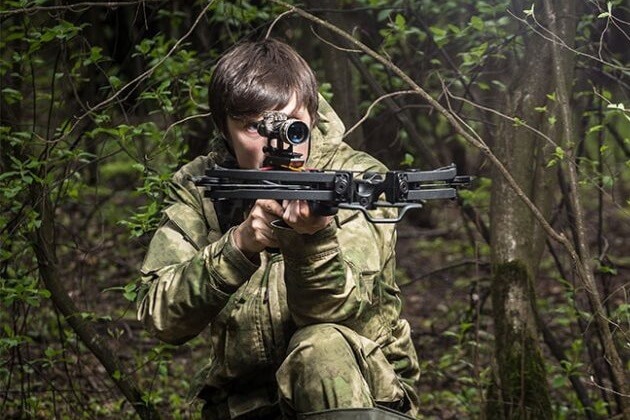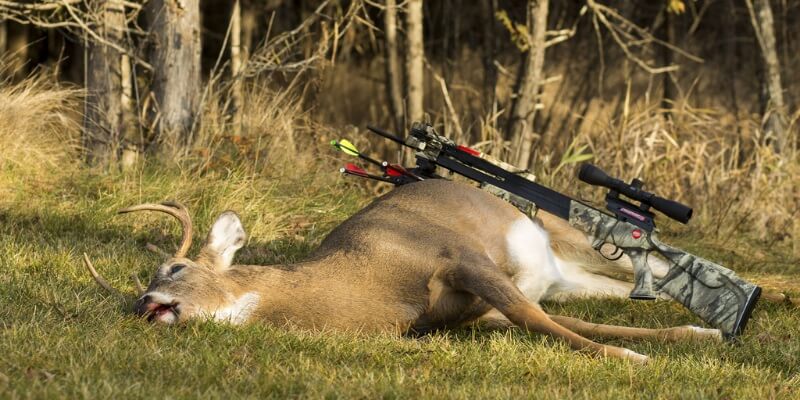Deer hunting with a crossbow has surged in popularity, drawing in both PRO hunters and newcomers. The experience offers a refreshing change from rifle hunting, requiring a unique blend of skill, precision, and patience. With a crossbow in hand, the hunter faces new challenges but gains the advantage of close-range engagement, making the hunt both thrilling and demanding. In this guide, we’ll cover 12 practical tips to promote your crossbow hunting, helping you strive with confidence and make ethical, well-placed shots. Whether refining your skills or just starting, these insights will set you up for a more rewarding hunt.
Deer Hunting Tips with a Crossbow
Take your time with this guide—it’s packed with insights that could make all the difference in your next hunt. Missing even one tip might mean overlooking a game-changing detail that could boost your deer hunting experience.
1. Understand the Crossbow Arrows
Choosing the right crossbow bolts is essential for achieving group shots, especially when targeting larger deer. An imbalanced arrow can cause the point of impact to vary by 2 to 12 inches at a distance of 30 meters. For a 50 cm crossbow, an ideal arrow length would be around 75 cm. I have tested 20 carbon arrows and all had tube warpages ranging from 0.001 to 0.010 inches. This irregularity will modify the point of impact.
Assembling your arrows and broadheads is crucial, as each setup performs differently. Whether you choose fixed or retractable broadheads, each has unique advantages and disadvantages. Broadheads with 2, 3, or 4 blades won’t have the same point of impact as practice tips, so testing is essential.
Damaged or warped feathers can also alter the point of impact by 3/4 to 2 inches at 30 meters, and even the arrow’s weight can affect accuracy. Unlike other projectiles, a broadhead arrow requires 16 times less energy to bring down a deer, as it slices through flesh, blood vessels, and organs.
2. Set Up the Crossbow Scope the Right Way
A crossbow reticle scope enhances your ability to aim with precision, featuring single or multiple crossed wires that provide a clear alignment mark. There are two main types of crossbow scopes: fixed power and variable power. Each scope is designed with horizontal lines, dots, small circles, or triangles, which serve as references for determining the point of impact based on the shooting distance.
With a variable power sight, the height of the bars adjusts according to the power transmitted to the arrow. For instance, if your central reticle is calibrated for shooting at 15 meters, it’s important to determine how far the additional bars (1, 2, and 3) compensate for hitting targets at 20, 25, and 30 meters.
- RECOMMEND TO READ: Best crossbow scopes for the money
3. Stand Yourself in a Proper Place
Hunting often involves tracking deer movement using trail cameras or rub lines that indicate travel paths. However, whitetails can be unpredictable, especially when they’re on the run. To adapt, many hunters position themselves slightly to the left or right, allowing greater freedom to swing their bow. Smart placement of your treestand can significantly enhance your comfort level while hunting. This becomes even more critical when using a crossbow, as its width, length, and weight can make movement more challenging.
4. Shooting Practice 20 to 30 Meters
The typical hunting arrow follows this direction. This curve must intercept the channel of the deer’s vital zone. For example, a 400-grain arrow starts its course at a speed of 350 feet per second. Make sure that the arrow flight remains in the vital zone without correcting the aim. It is necessary to shoot at a maximum distance of 26 meters to kill a deer. The maximum reasonable distance with which an accurate and lethal shot can be performed is approximately 30 meters.

Unexpected deer movements, awkward shooting angles, nervous release, and misjudging distance are just a few factors that can lead to missed shots. Unlike a bullet, an arrow’s flight path is influenced by gravity and air resistance, causing it to drop more quickly. This means that every meter counts when shooting with a crossbow. To ensure accuracy, using a rangefinder is essential. It allows you to gauge the exact distance to your target, helping you adjust your aim and improve your chances of making a successful shot.
5. Shoot the Right Point
An improperly placed arrow does not deliver the necessary lethality for a quick and humane kill due to its lower energy and mode of action. It’s crucial to aim for the vital zone, as much of the heart-liver-lung area is shielded by the rib cage. The arrow needs sufficient energy to penetrate this natural barrier effectively. As previously mentioned, aspire to shoot within 30 meters of the deer for the best chance of a successful, ethical kill.
6. Understand the Behavior in the Wind
A wind that arises halfway along the flight path (around 14 meters) has minimal impact on arrow grouping and point of impact since the arrow is already stabilized. However, wind acting 4.5 meters from the shooter can significantly affect both the point of impact and grouping.
In such cases, the grouping can widen by 1 to 2 meters, and arrow dispersions can be as much as 2.5 meters! Therefore, mastering the skill of “reading” the wind is crucial for effective shooting. You can compensate for its effects by adjusting the turrets of your telescopic sight or by off-centering your aiming point.
7. Deer Reaction (Sound Level)
The call of a female deer typically reaches a loudness of approximately 60 decibels. In contrast, crossbows produce a firing sound averaging around 90 decibels. Even though crossbows often incorporate noise reduction systems to dampen these effects, hunters need to be aware that the discharge of a crossbow can still generate a noticeable level of noise.

Crossbows are designed for short-distance and lower-speed shooting compared to firearms. It is obvious that the game hears the release, including the ultra-high frequency vibrations, and tries to flee.
The swiftness of white-tailed deer makes them adept at evading danger, particularly when a shot is fired from less than 30 meters. Unlike moose, white-tailed deer are highly reactive to close-range shots. This presents a challenge for hunters, as firing from a greater distance to minimize noise isn’t practical; the distance needed would be unreasonably large to deceive these vigilant animals effectively.
Arrow speed is fixed and cannot match the speed of sound, which exceeds 1,050 feet per second. Therefore, hunters must get closer to the deer to minimize the time between the sound reaching the deer and the arrow’s impact.
If this interval is less than four times faster than that of humans (the animal’s reflex time), your chances of reaching the vital zone increase. However, shooting from more than 30 meters may result in insufficient kinetic energy, leading to poor penetration and potentially only injuring the animal.
8. Choice of Camouflage
The outfitter also offers the possibility of enjoying an exclusive territory in self-guided mode. Your camouflage hunting outfit is based on the type of animal you are hunting. To hunt deer and other big game, be aware that these animals have difficulty distinguishing specific colors. Longer wavelengths such as orange, yellow, red, and pink are less likely to be detected. But, go for an outfit that breaks your figure and helps you blend in with the scenery. It is also necessary for your safety so that certain animals do not detect your silhouette and movement. A camouflage outfit with fluorescent colors also facilitates your shots.
9. Make Sure You’re Always Safe
- Hunting is not a risk-free activity, you have to think about your safety above all
- You must have to wear suitable clothes
- Test the cracks, and the color changes on your branches and improve the weakness
- Check the width of the axle to axle of your crossbow without tension to validate the safety space in your caches;
- Tighten all screws and seal the screw head properly
- If your crossbow is not fitted with a finger protector, use extra caution when pulling
- Keep the fingers of the supporting hand under the crossbow
- Confirm the warping of your arrows by rolling them on a flat surface
- Ideally, align your fixed broadheads with your feathers
- Check that the notch is 90 degrees with the rooster feather
- Always check that your arrow hits the string before shooting to avoid making an empty shot
- Check the arrow for cracks
- Maintain social connectivity
- And stay hydrate
10. Essential Accessories for Deer Hunting
- Rangefinder or binoculars
- Rigid and flexible carrying case
- Quiver
- 6-10 identical arrows (length, size, weight)
- 6-10 identical hunting blades (fixed or retractable)
- 6-10 practice points of the same weight as your broadheads
- Rope wax
- Lubricant for bridge
- Hexagon wrench
- Spare rope already stretched
- Rope tensioner (stretching system)
- Extension cord
- Boom puller
- Accessory (key) to change tips
- Lens cleaner and wipe
- Battery for crossbow scope, rangefinder or binoculars
- High-density styrofoam practice block
- Surveyor’s tape (biodegradable if possible)
- Survival knife
- Disarmament arrow
- Right bow hunting backpack
11. Access to a Bloodhound
Sometimes it is necessary to call in a bloodhound to locate the injured game, especially if the visual clues are nonexistent or difficult to interpret. From an ethical point of view and for your recovery, the bloodhound is an essential part of the search for a game injured (fatally). In addition, for a negligible amount of money, you will save a hunting party that costs you a lot more.
12. Maintain Your Crossbow
There are several advantages to maintaining your crossbow: first, it makes your shooting weapon more efficient, and second, the shooting accuracy will always be there and you are less likely to have to deal with shooting incidents. However, maintenance is not cookie-cutter; you have to follow certain steps.
- Start by checking your shooting rope
- Check the condition of your crossbow pulleys
- Control the body of your crossbow
Conclusion
With over 6 years of experience in hunting reporting, including visits to numerous hunting locations and interactions with passionate hunters, I saw that crossbows perform well with arrows of equal weight and at close range, up to 30 meters. As already said, for distances greater than 30 meters, using a rangefinder or binoculars is essential. I have observed a notable increase in the risk of injuring the animal due to the unpredictable impact of wind, affecting arrow trajectories at various weights.
When practicing shooting in the living area, always shoot with the same arrows you will use when hunting. The success rate of deer hunting relies heavily on consistent practice at various distances and under diverse climatic conditions. For more information about crossbow hunting, you can check my other articles.
Thanks for reading!
If you have any questions, leave a comment below and I will answer them.

How does wet weather effect my crossbow’s performance?
Wet weather can affect your crossbow by making the string and rail less efficient, reducing accuracy. Water can cause rust on metal parts and weaken the string over time. Always dry and lubricate your crossbow after exposure to rain to maintain performance and longevity.